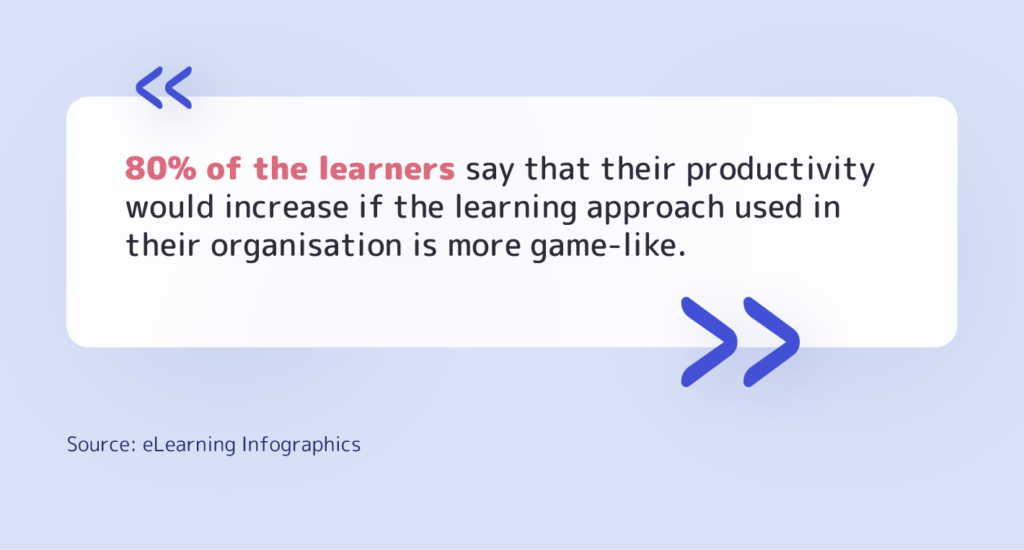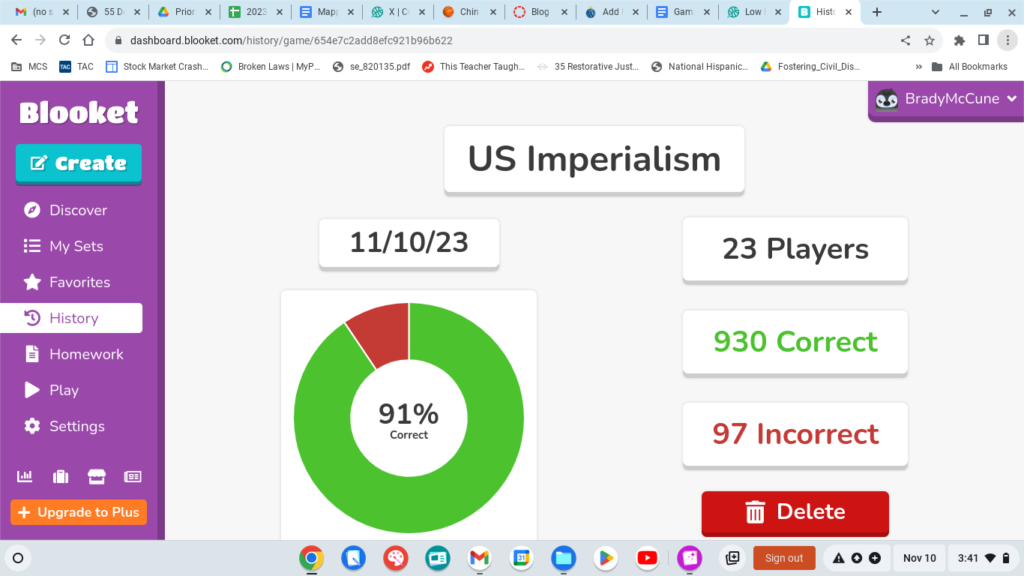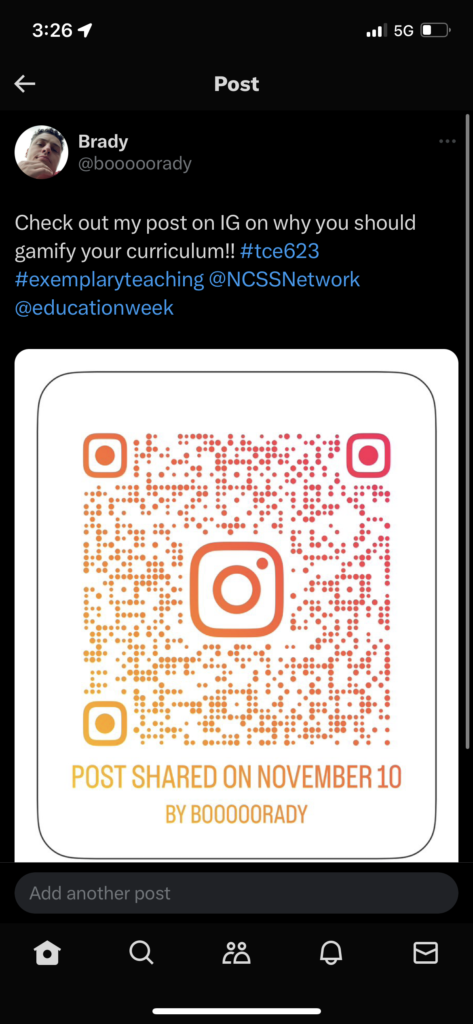
I have always been a “gamer.” When I was younger and home “sick” from school, I would sneakily plug in a gaming system while my grandma watched her shows. I loved playing games, I was a four sport athlete, played video games, would do trivia, and was a board game enthusiast. Games made me think, and use all the skills that I was learning and crafting at the time. School felt like a really dumb game, that was more concerned with accumulating points (grades) rather than actually playing (learning) (Fully Engaged 16).
From readings that I have done, I have seen the idea of the need to move past this boring game of school and actually gamify students’ learning. The idea is to convince learners to move beyond their comfort zones and gradually surrender to a playful spirit that will help them in the classroom and in their lives. (Fully Engaged 46). Gamification is all about intrinsic motivation (Fully Engaged 22), students should want to learn and participate in these activities. It is not just about reviewing information so they can score well on the next test, it is about actually having fun while learning.
Gamification in education can enhance the learning experience by introducing game elements, such as challenges, rewards, and competition, which can make the educational process more engaging and enjoyable for students. This engagement often leads to increased motivation and participation, fostering a positive learning environment. Additionally, gamification can tap into students’ intrinsic motivation by providing a sense of achievement and accomplishment.
Creativity and innovation can be nurtured through gamification by incorporating open-ended challenges, problem-solving scenarios, and collaborative activities. Games often encourage experimentation and exploration, allowing students to think outside the box and develop creative solutions. Furthermore, a well-designed gamified learning experience can promote a growth mindset, encouraging students to embrace challenges and view failures as opportunities for learning and improvement.
TCE Thresholds
- Curriculum is more than standards, textbooks and courses of study
- School should be fun
- Students should have fun learning
- Teachers should have fun teaching
- Gamifying our learning allows students to use many different skills and hone their skills that will be essential to them outside of school.
- Games give students a chance to escape the day to day grind of school, and give them a chance to immerse themselves into a new reality that allows them to work with content and curriculum in a way that lets them make mistakes and motivates and rewards them for learning.
- Curriculum is co-constructed
- The design of games should involve feedback from both teachers and students, with this collaboration gamified lessons can be more effective and align with the needs and preferences of the students
- Gamifying learning makes the learning process more interactive and student-centered.
- Games require students to be willing participants, and this allows them to be at the forefront of the construction of games, the teacher usually makes the rules of the game and the students follow them and hold each other accountable. This creates the game, and a co-construction of curriculum.

Gaming in Mr. McCune’s American History Class
This week I played Blooket with my students, and tried all the different game modes that they had. Blooket has game modes such as “Battle Royale” where students go head to head against each other while answering questions, whoever gets it the fastest wins the round. Each student has 5 lives, and if you lose a round you lose a life. At the end, we had two students go head to head on the big screen and it gave the class a ton of energy! Another game mode that I tried was “Crypto Hack” students make a password, then answer questions to “mine crypto” if they get the answer right they get to mine the crypto by picking one of three boxes, each with a different outcome, some might give +10 crypto, or double crypto, or an opportunity to hack another students crypto and guess their password. The students had so much fun with this and every game they were engaged for the entire time.
I played this while teaching vocab, and it was incredible. The students were learning the words so fast, and so much more efficiently than they did by my previous assignments. They kept asking to play again, and we have played it every single day this week. They know the vocab like the back of their hand, and now I have shifted assignments to use Blooket as a warm up or exit slip for students. It has helped them with engagement and content, and has made my class more enjoyable for them and for me!!
Challenges: Figuring out the game, and taking the risk to try it. Getting students used to playing, and running into a paywall for some features of blooket.
Successes: Student engagement, Achievement, Fun.
Different: I really wouldn’t change much, maybe just be able to try all the different games and let the classes choose which ones they like the best.

Interactions with Others!!
https://educatoral.com/wordpress/gamification/ https://www.upshot.ai/blog/gamified-learning-and-the-science-behind-it/?unapproved=23135&moderation-hash=a1166939e9fa8122ebe65b3806dcb199#comment-23135


Hey!
Your introduction to your blog was awesome! I loved how you compared school to as a game and how you say the playing, or learning, is the most important part of gaming, or schooling. I’m a big gamer and I completely agree that the playing is the best part of the game. I always loved completing the main quests, but I always tried to complete the side quests too. I think incorporating gaming elements in the classroom is important and it can be done with planning and purpose. Using gaming to teach vocabulary was an excellent idea. I find teaching vocabulary can be sometimes boring and more about memorizing than actually learning what the word means. Also, I can relate to your challenging moment of having students take the risks while playing the game. I believe that goes back to our education system focusing on the ‘correct’ answers instead of the process and risk taking.
Thank you for sharing!
Hi there!
I appreciate you sharing your blog article about enhancing the enjoyment and engagement of history classes with games like Blooket. Reading about your experience incorporating video games into the curriculum was a lot of fun. It’s wonderful to hear that it has motivated your pupils and assisted them in picking up and remembering language.
You make a really good point about how games may foster a sense of accomplishment and internal motivation. Students’ innate need for challenge, engagement, and enjoyment can be satisfied by making learning feel more like play. Perhaps it explains why they want to play Blooket every day!
As a lifetime player yourself, it’s fascinating to hear your perspective as well. When you present new games to your students, I’m sure that passion shows through. Your enthusiasm must be contagious and aid in quickly enlisting them.
All things considered, this is such a great illustration of how to use gamification and technology to bring history class to life. We appreciate you attempting a novel approach to teaching by taking a risk. If you are successful, other educators will be inspired to use more game components as well. Kindly don’t stop sharing your stories! As you continue gamifying your program, I would love to hear more.
Thanks Maddie! I appreciate your reply and it makes me feel as if I actually know what I’m doing in the classroom, thanks for the confidence boost!